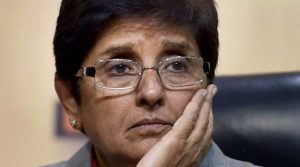
16-01-2017 (Important News Clippings)
To Download Click Here
Running on empty
How water might dissolve the Indian Union if it can’t resolve river disputes

The history of the new capital was not so auspicious. Akbar used it only for 13 years and then abandoned it to return to his old capital permanently. The main reason was very severe water scarcity.
Fatehpur Sikri is a magnificent monument to India’s poor water planning. Over the centuries India’s water planning has improved incrementally whereas its drivers of water use have increased exponentially, making its water situation worsen steadily with time.Take population, only one driver of increasing water use. In 1947, the total population of undivided India was 390 million. By, 2050, total population of the three countries of undivided India will be 2,206 billion, a 5.66-fold increase in little over a century. India is expected to overtake China around 2022 as the most populous country in the world.
Population growth, rapid urbanisation and industrialisation and exponential growth in human activities over the past century, have resulted in higher water requirements for all types of water uses: human, thermo-industrial and agricultural.Furthermore, for centuries domestic and industrial wastewaters have been indiscriminately discharged to water bodies without any, or partial treatment. Consequently, all water bodies within and near population centres have already been contaminated seriously with domestic and industrial pollutants. This has posed serious health and environmental problems.
In addition, with steady economic growth, higher literacy and increasing skill levels, the number of Indian middle class families has gone up exponentially. The median income of Indian households is expected to reach over $10,000, by 2030, in 2014 prices. Direct results of this affluence have been rapid changes in dietary patterns and energy consumption levels. As the country has prospered, people have moved to a higher protein-based diet like milk products, fish and meat, all of which need significantly more water to produce than cereal-based diets. Their energy consumption has gone up because of increasing use of refrigerators, washing machines and cars. All these need extra energy and no energy can be generated without significant amount of water.
In terms of water, the country now is facing a perfect storm. This means water management practices in India need to change dramatically in the coming years. However, we do not see any sustained political will which will be essential to take some hard decisions in the future.The problem is further exacerbated by the fact that all important rivers in India are interstate, and water management is basically a state subject on which the Centre has very limited control.
Because of poor water management in all the Indian states and steadily increasing water demands, India is now witnessing increasing conflicts on water allocations in interstate rivers. This has become a serious challenge to the regional stability of the country.Interstate water allocation conflicts have triggered numerous protests, violence and property destruction. If these conflicts continue and grow, they may prove to be one of the biggest political constraints to India’s future economic growth and social cohesion.
A major challenge now is the absence of permanent and efficient dispute resolution mechanisms for water allocation in interstate rivers. Under the Interstate Water Disputes Act of 1956, ad hoc tribunals can be established on a case by case basis whenever conflicts between two states cannot be resolved by mutual discussion. The objective of this Act was to allow the states to discuss and resolve the conflicts before engaging in adjudication.Our research indicates that tribunals have often contributed to long-drawn negotiation processes which have led to hardening of the positions of the individual states, instead of promoting compromises.
There are several problems with the existing tribunal system. First, there are no uniform, logical and common processes. They have considerable discretions in terms of processes to arrive at settlements as also underlying concepts under which settlements are made. Fundamental assumptions have often varied from one tribunal to other significantly.
Second, tribunal results are non-binding to the states.
Third, the Centre has been reluctant to establish institutions for implementing the awards.
Fourth, there is no fixed stipulated timeframe for negotiations and adjudications. The Cauvery Tribunal took 17 years. Karnataka then promptly decided to file a Special Leave Petition to the Supreme Court to thwart the final award, further delaying the settlement.
An important factor linking water disputes to state politics is the power of state campaigns in distracting voters from real issues of poor governance and lack of administrative skills and actions. Water has now assumed the role of a political weapon.With a number of states defying orders of tribunals and Supreme Court, water is becoming an important threat to Indian’s federalism and future social and economic development.In the absence of functioning water institutions at central and state levels and lack of political will to take hard decisions of all political levels, interstate water allocation problems will become increasingly more difficult to resolve. It proves Mark Twain’s adage “Whiskey is for drinking, water is for fighting over.”
Asit K Biswas is Professor and Cecilia Tortajada is Senior Research Fellow, National University of Singapore. Udisha Saklani works with Institute of Water Policy
Budget 2017
Why do we need an institutional evaluation mechanism?

The outcome Budget, launched in 2005-06, was meant to track actual implementation of schemes and fix accountability for lapses. However, ministries cobbled together unwieldy documents that reflected poor understanding of the goal, raising doubts over its efficacy to measure performance and improve service delivery, regrettably. Reportedly, ministries are sending progress reports on programme implementation to the Prime Minister’s Office.
We need a proper institutional mechanism to assesses flagship schemes to enhance the quality of implementation and outcomes. Take the example of education. Merely spending money or writing rules on primary education will not suffice. Learning outcomes should be better and that, in turn, calls for both empowering and holding teachers to account. A robust institutional mechanism can convert criticism into improvement.Segregating expenditure as Plan and non-Plan blocks a holistic evaluation of outcomes. So, it is welcome that the government wants to do away with the distinction in the coming Budget.
The Rangarajan committee’s recommendation earlier to shift to a multi-year time horizon and shift to outcome-linked expenditure management makes sense. Budget outlays should be based on detailed project reports that are absolutely clear on final targets, milestones and precise funding requirement at every stage, be it building roads, schools or toilets.
Date: 16-01-17
Fiscal discipline
States must raise more of their own taxes

The combined debt to GDP ratio of about 66% in 2014-15. Official data comes with a huge lag. Last year, rating agency Moody’s forecast combined fiscal deficit of the Centre and states at 7.2% in 2015-16. This is well above the combined yearly limit of 6% recommended by the 14th Finance Commission for the period 2015-16 to 2019-20. Aspecial report by Ind-Ra on the budget performance of 23 states has estimated that budgetary targets are likely to be missed in FY17. Only 12 states had a revenue surplus in FY16 and qualify for additional borrowings.
At an aggregate level, states are likely to have had a revenue deficit for a third consecutive year in FY16. This is disconcerting. States have their own resources: the value-added tax on petroleum, a money spinner, accounting for nearly 18% of their revenues. States’ share of tax devolution too rose to 42% from 32% of the divisible pool, based on the 14th FC recommendation. However, central transfers (share in central taxes plus grants-in aid) declined by 0.3% of GDP in 2015-16, as many centrally schemes were withdrawn. The states and the Centre must adopt the Goods and Services Tax at the earliest to boost revenues.
Once adopted, GST will put paid to luring investment via tax concessions. Better governance and infrastructure would become the differentiating factors. In order to raise resources on their own, the states need to improve their credit rating. And greater fiscal discipline is the key to better ratings. For their own sake and for the sake of the nation’s overall macroeconomic health, the states must put their fiscal house in order.
Put the onus on teachers
Over the same period, the number of “tiny” public schools — those with a total enrollment of 20 or fewer students — rose sharply.

Over the same period, the number of “tiny” public schools — those with a total enrollment of 20 or fewer students — rose sharply. In 2014-15, these nearly one lakh tiny public schools had an average enrollment of only 12.7 students per school, a pupil-teacher ratio of only 6.7 students per teacher, a per-pupil teacher-salary expense of just under Rs 80,000 per student per year, and a staggering teacher salary bill of Rs 9,440 crore. The number of public schools with only “50 or fewer” students rose even more dramatically to 3.7 lakh small schools, that is, to 36 per cent of the total 10.2 lakh public elementary schools in the country by 2014-15. These 3.7 lakh “small” public schools had, on average, only 29 students per school, a pupil-teacher ratio of only 12.7 pupils per teacher, a per-pupil-teacher-salary expense of Rs 40,800 per year per child, and a monumental teacher salary bill of Rs 41,630 crore in 2014-15 — a grotesque squandering of tax-payers’ resources on pedagogically unviable public schools.
Why are public schools sick and emptying? A high teacher absence rate of 25 per cent nationally, low time-on-teaching even when teachers are in school (identified in the PROBE-2 Report) and the inability of education officials to implement the sanctions, specified in the rules, against erring teachers, because teachers are supported by powerful unions and sheltered by teacher-MLAs/MLCs, are the chief reasons. The truancy of public school teachers is also not because they are low-paid; they are significantly better-paid than private school teachers, and also better-paid than teachers in other countries: As per a NUEPA study, their average salary was Rs 4.8 lakh in 2014, which was more than seven times the per capita income of India. Compare this with China, Pakistan, Bangladesh and Indonesia, where teacher salaries are less than two times the per capita incomes.
The formulation of the National Education Policy (NEP) provides a once-in-a-generation opportunity to cure the sickness. Education policymakers in India have historically prescribed the wrong medicine. While inputs-based policies are largely discredited internationally, in India, inputs-enhancing policies that neglect accountability have sadly been given legislative force under the Right to Education Act 2009. For starters, the draft NEP needs to adopt “increase of accountability” as its central organising theme. The government must also embrace proven policies that have worked elsewhere to raise accountability.
Per-student funding, used in educationally advanced countries, is the single most powerful way of improving school/teacher accountability — and teachers who slacken in effort stand to lose out financially under this scheme. Further, instead of giving per-student funding to schools directly, giving it to schools indirectly via a school voucher to parents (Direct Benefit Transfer or DBT) empowers parents. Where teachers are lax, parents withdraw their children, taking their voucher with them (to another school), thus lowering the government grant receivable by that school. This ability of parents to impose a financial penalty ensures that schools and teachers remain accountable, even to poor and uneducated parents — accountability structures are inherent and inbuilt within per-student DBT funding.
DBT voucher schemes can improve equity, compared to the counterfactual (current) situation, by entitling every BPL child in the country to attend a private school of their choice, or at least, to fill 25 per cent seats of private schools under the RTE Act 2009 — since there is no lobby to oppose this DBT way of reimbursing private unaided schools. In due course, this could be extended to public and aided schools.
The shambolic accountability system governing publicly-funded schools requires that the NEP includes even more far-reaching and courageous political economy and governance reform. It requires amendment of Article 171 (3c) of the Constitution that guarantees teachers representation in the state legislatures; this has turned many teachers into politicians (for example, 17 per cent of all MLCs in the UP Upper House are teachers); it requires that publicly paid teachers in aided schools be recognised as holding an office of profit under the government, thus debarring them from contesting elections. This will dismantle the culture of political activism which diverts teachers’ attention from teaching; this also requires the Election Commission to reduce the proportion of teachers in the official team manning polling booths during election time.
The NEP must steer the education system away from being run for the promotion of teachers’ interests, towards being run for improving children’s outcomes. This requires the government to take a firm and principled rather than an expedient stance—with DBT school voucher funding and governance reform. The children of India deserve it.
Date: 14-01-17
The Dignity of her Office
Kiran Bedi’s talent could be Puducherry’s gain, but she needs to tone her language

The Indian Constitution has chiseled an active and executive role for the prime minister and chief ministers, and more “conservative” and “overlooking” responsibilities for the President and those holding gubernatorial positions. The means, methods and implied perceptions emanating from such gubernatorial intervention hold the key to this delicate system. The morality and dignity of the chair cannot be lowered to meet the mainstream temptations of
“action-orientedness”.
It is true that the LG’s office is relatively more “administrative” than a conventional governor’s. If a state or UT has the benefit of an LG with skills and accomplishments in a certain domain, as indeed Puducherry does with Kiran Bedi, the same ought to be used for the benefit of the state and its people. Unlike inter-party or intra-party rivals, the LG and CM do not compete with each other for electoral gains. In fact, Bedi’s claim to fame is due to her professional accomplishments, and herein lies an invaluable opportunity to redefine cooperative federalism.
Beyond the technicalities of being bound by the “advice” of the council of ministers, the governor has to finally render his/her “advice” only after ensuring its constitutional compliance from a prism of non-partisanship. Else, the import of punishing the government with a “return” or “review” of a file can only be explained in the calculus of morality. The brilliance of constitutional intervention in the democratic framework was exemplified by the late President K.R. Narayanan, who personified constitutional propriety in the most dignified, revolutionary, yet reformatory way. From “returning for reconsideration”, the files pertaining to the imposition of President’s rule (and succeeding in protecting the federal instincts), standing in line to exercise his franchise, to deftly working on presidential drafts and articulating views that often reflected opinions different from that of the elected government, Narayanan was constitutionally protectionist, reformist and action-oriented at the same time — this, without lowering the collective dignity of the will of the people that was manifested in the elected government of the day.
Certain genuinely apolitical interventions by the constitutional heads do run the risk of acquiring a political colour, given the different political dispensations in the state/UT and the Centre. However, commenting on the incumbent chief minister in one of her write-ups Bedi noted, “…and here comes the chief minister of Puducherry who decides to put a ban on use of social media in all official communications. He even threatens officers with departmental action if they do not drop out of the groups.” The point is beyond the inelegance of expression or the public mainstreaming of dissent — that is the individual’s prerogative. However, the tone and its public mainstreaming militates against reconciliatory options in a more civil, discreet and mature way. Such public grandstanding could potentially discolour even the genuine points of gubernatorial displeasure.
Bedi’s gubernatorial assignment requires her to adapt to the role in a manner that is less confrontational, and still not a “rubber-stamp” — in Indian democracy, the opposite of confrontational need not be conformist. In an era of extreme societal polarisation, divisiveness and vitriolic politics, there is a need to soothe the frayed nerves of the electorate. Such a healing touch can only come from the “conscience-keeper” of a state/UT, who is above the humdrum of political intransigence. Bedi has the intent, capabilities and options to deliver her stated promise to the citizens, and to her own talent, as long as she overcomes her own instincts.
